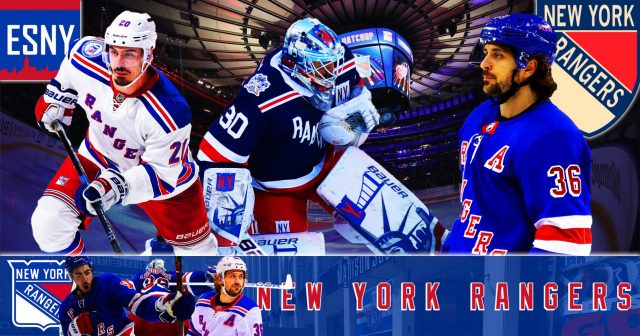Rick Nash Continues To Be A Enigma For The New York Rangers

Forward Rick Nash is among the elite goal scorers in the game. Why can’t he replicate that success in the playoffs?
By William Chase
 Rick Nash is one of the most pure goal scorers in the NHL.
Rick Nash is one of the most pure goal scorers in the NHL.
Originally drafted by the Columbus Blue Jackets in 2002, the skilled forward dazzled into an elite scorer, putting up 41 goals in just his second season, and finishing in a three-way tie for the Maurice “Rocket” Richard trophy for league’s top scorer. Nash was the lone bright star in Columbus, as the team tried but ultimately failed to produce a winner. This, along with more rebuilding, opened up the door for him to be traded and ultimately made his home on Broadway.

When the trade between the Blue Jackets and New York Rangers occured during the summer of 2012, big things were expected of both the team and Nash. He was considered the missing link; the piece to get the Rangers a Stanley Cup.
The Blueshirts had just lost the Eastern Conference Finals to the New Jersey Devils the year prior and were desperately seeking more scoring. The biggest name was coming to New York and the Rangers had gotten their guy.
Nash’s first campaign during the lockout shortened 2012-13 season was up to his usual par, as he scored 21 goals, leading the team, and put up 21 assists finishing second on the team in total points.
However, he drew criticism for his playoff performance producing one goal through 12 games. He scored three goals in the 2013-14 playoffs and five in the ’14-15 playoffs.
During Nash’s years in Columbus, the talk centered around getting him the proper help on the ice. The Jackets’ trade for Jeff Carter in 2011 allowed Nash to line up with the best center he ever had in Columbus, and the team was expected to contend for the playoffs.
He went into isolation the initial weeks after the trade to Columbus went down, then he battled injuries and ultimately never blossomed the way the Columbus had hoped. Traded almost immediately as soon as he was brought in, the Blue Jackets continued to flounder and the team was looking at another rebuild.
At the time of the trade, Nash was quoted according to Dave Lozo of NHL.com as saying:
[quote_box_center]Initially, I went in with [GM] Scott Howson and was trying to get a game plan on what was going on with Columbus and I was told there was going to be a rebuild,” Nash said. “I’ve been here for nine years now and figured I could be the main piece of a rebuild for them in that case. If the circumstance was right, I’d waive my no-trade clause and help them rebuild and help my career carry on[/quote_box_center]Speculation would continue to ramp up concerning trade talks and Nash. When he wound up in New York, he would finally have the necessary line-mates and help he needed.
Which was why it was so puzzling when he struggled at times, most notably in the playoffs.
Of course, let’s not forget this was his first playoffs on the big stage. His only prior experience came in 2009 when the Detroit Red Wings made quick work of Columbus in a 4-0 Quarterfinals sweep.
Coming into New York with the expectations of being the sniper the Rangers sorely needed, and seen as the missing piece to the ultimate prize, he was supposed to do what fans were accustomed to seeing him do. Instead, he struggled under the colossal New York pressure.
These things take time. Not everyone is going to thrive in New York. As it turned out, Nash just needed to continue his adjustment.
Though his offense largely disappeared during the Rangers’ Finals run in 2014, he was praised for his defensive play.
Nash was a new man in 2014-15, scoring at a blistering rate and finishing with a career-high 42 goals.

Though, he has been criticized for his lack of scoring touch in the playoffs, it’s not for a lack of trying. He led the 2013-14 playoffs with 83 shots on goal, while only scoring three times. The year prior in the 2012-13 playoffs, he was tied for 23rd with 42 shots, only scoring once.
Obviously when your best players are counting against the salary cap at $7,800,000, they must find the back of the net. Defense, assists, and other aspects of the game don’t keep the fans content. While Nash has been a solid all-around player, its the goal scoring that one making near $8 million a season must come through on.
As great as he has proven to be at Madison Square Ga rden during the regular season, the puck has to find the back of the net in the postseason.
rden during the regular season, the puck has to find the back of the net in the postseason.
Nash gets his shots, and finds scoring opportunities. It can’t all just be bad luck, can it? This isn’t as cut and dry as Alex Rodriguez striking out in October.
He has suffered concussions — missing 17 games in 2013-14 — which very likely affected his play, not just physically but mentally. Known for playing a gritty game, and not afraid to be physical and play down low, it’s likely any mental hurdles could have attributed to Nash come playoff time when intensity ratchets up.
He ended up with 26 goals despite the 17 games missed in 2013, but disappeared in the playoffs.
Nash has one goal so far this season — an empty net as luck would have it. While he’ll likely produce his typical amount of goals this season, it’s the playoffs that appears to be a tale of two seasons.
Next: New York Rangers Keep The Duc Quiet In 4-1 Win
William Chase is editor at Elite Sports NY, and has been featured on such prominent websites including Bleacher Report. William is also currently the Marketing & Media Relations Intern for the Augusta GreenJackets.






